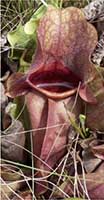RESEARCH: Evolution of carnivorous plants (1) Development of carnivorous pitcher leaves of Sarracenia purpurea
Complex morphology is one of the major evolutionary outcomes of phenotypic diversification. In some carnivorous plants, the planar leaves of common ancestors have been modified to form a pitcher shape. However, how leaf development was altered remains unknown. Here we show that the pitcher leaves of Sarracenia purpurea develop through cell division patterns of adaxial tissues that are distinct from those in bifacial and peltate leaves, subsequent to regular expression of adaxial and abaxial marker genes. Differences in the orientation of cell divisions in the adaxial domain cause bifacial growth in the distal region and adaxial ridge protrusion in the middle region. These different growth patterns in a leaf establish the pitcher morphology. A computer simulation suggests that the cell division plane is critical for the pitcher morphogenesis. Our results imply that tissue-specific changes in the orientation of cell division underlie the development and evolution of a morphologically complex leaf (Fukushima et al. 2015. Nature Commun. 16: 6450).

Leaves of Sarracenia puupurea
- Development of carnivorous pitcher leaves of Sarracenia purpurea
- Evolution of digestive enzymes
- Molecular Mechanisms of Memory of Dionaea muscipula leaves
(link to "Mechanisms and evolution of plant movement") - Molecular mechanisms of plasticity in Cephalotus follicularis
- Genome analysis of Drosera spatulata and development and evolution of tentacles, and homology between Drosera and Dionaea traps.
- Development and evolution of Nepenthes pitcher leaves

